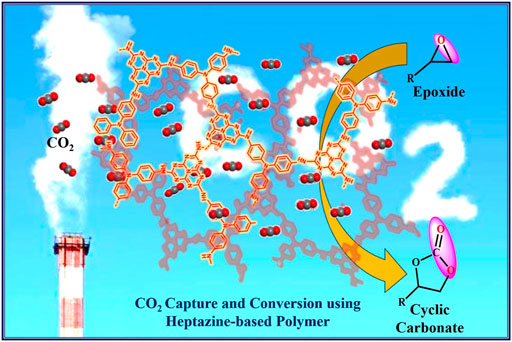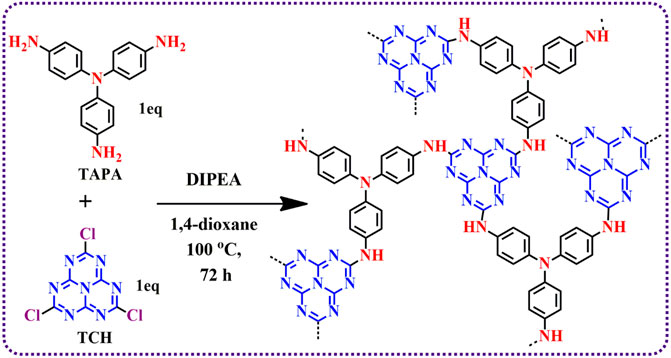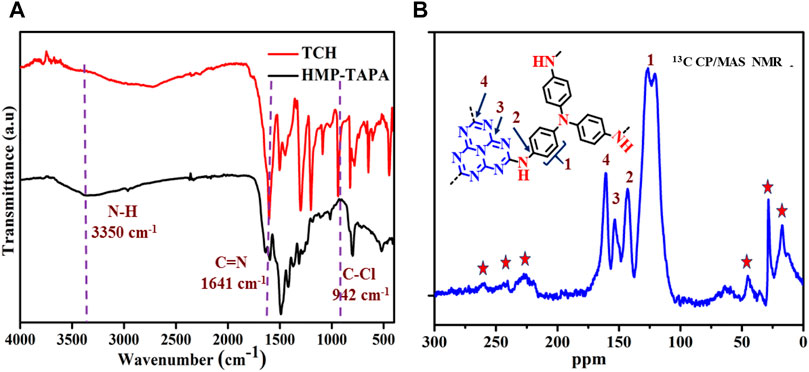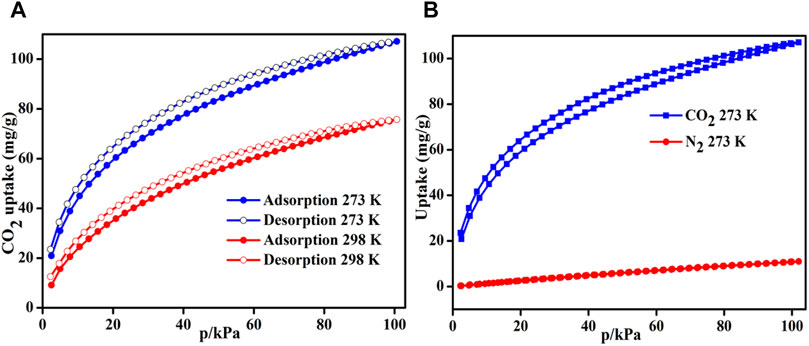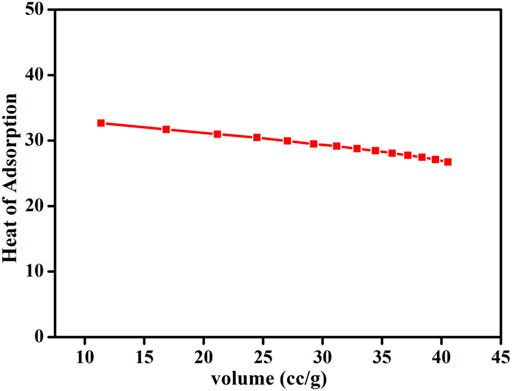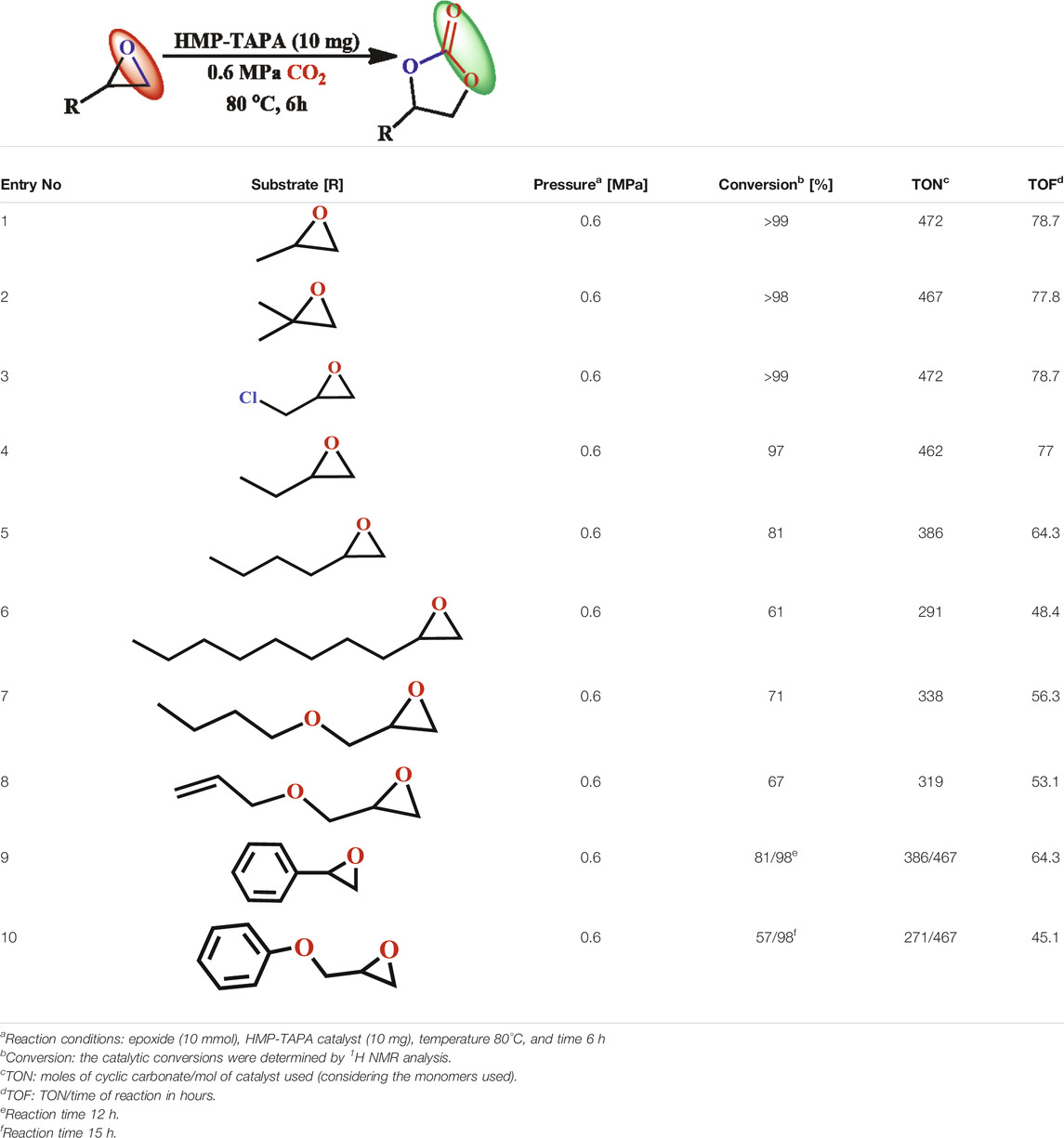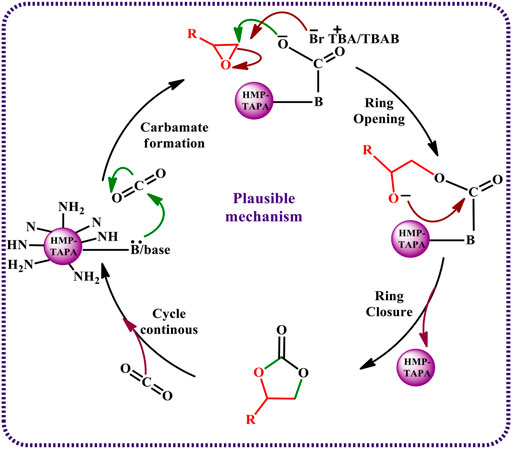- Advanced Functional Nanomaterials, Energy and Environment Unit, Institute of Nano Science and Technology (INST), Mohali, India
The capture and catalytic conversion of CO2 into value-added chemicals is a promising and sustainable approach to tackle the global warming and energy crisis. The nitrogen-rich porous organic polymers are excellent materials for CO2 capture and separation. Herein, we present a nitrogen-rich heptazine-based microporous polymer for the cycloaddition reaction of CO2 with epoxides in the absence of metals and solvents. HMP-TAPA, being rich in the nitrogen site, showed a high CO2 uptake of 106.7 mg/g with an IAST selectivity of 30.79 toward CO2 over N2. Furthermore, HMP-TAPA showed high chemical and water stability without loss of any structural integrity. Besides CO2 sorption, the catalytic activity of HMP-TAPA was checked for the cycloaddition of CO2 and terminal epoxides, resulting in cyclic carbonate with high conversion (98%). They showed remarkable recyclability up to 5 cycles without loss of activity. Overall, this study represents a rare demonstration of the rational design of POPs (HMP-TAPA) for multiple applications.
Introduction
Carbon dioxide (CO2) has attracted significant attention as a greenhouse gas which is considered to be a major contributor for global warming and subsequent climate changes. (Aresta et al., 2014; Pera-Titus, 2014; Mukherjee et al., 2019). During the last 10 years, the mean annual absolute CO2 concentration has increased by 2.21 ppm per year (Van Humbeck et al., 2014). Furthermore, various human activities including burning of fossil fuels have been contributing for the increase in the concentration of CO2 in the atmosphere and have resulted in serious environmental issues, like extreme weather and acidification of oceans (Tiba and Omri, 2017; Ding et al., 2019). Furthermore, coal-based power plants are known to contribute about 45% of the overall CO2 emission, and it is important to capture carbon dioxide from flue gas before releasing it to the atmosphere. Recently, a global initiative has been taken on the urgent need to develop technologies and processes for the effective capture and sequestration/separation of CO2 from post-combustion effluents such as flue gas wastes. Hence, extensive research efforts are being carried out by researchers worldwide on the development of systems for efficient carbon dioxide capture and storage (CCS) (Kitagawa et al., 2004; Yaghi et al., 2003; D’Alessandro et al., 2010; Bui et al., 2018). In this regard, the currently employed amine-based liquid-phase absorption technique is considered to be costly and energy-intensive. On the other hand, the adsorption of carbon dioxide on porous solid supports has been considered as a promising viable technique for CCS application because of its low energy requirement. In this context, solid porous adsorbents such as zeolites and activated carbons have been investigated for their potential applications for CCS (Rubin et al., 2007; House et al., 2009). Recently, POPs have emerged as promising candidate materials for selective CO2 storage and separation applications (Makal et al., 2012; Roeser et al., 2012; Su et al., 2017). In this regard, several strategies have been employed for modulation of the pore surfaces to induce selective gas adsorption property in the framework by the incorporation of Lewis acidic/basic sites and immobilization of polar functional groups (–NO2, –NH2, –CONH2, –CF3, etc.) (Yue et al., 2020). On the other hand, CO2 has gained considerable interest as a renewable, non-toxic, inexpensive, and an abundant C1 building block for high-value chemicals and fuels (Sakakura et al., 2007; Chu, 2009; Jacobson, 2009). However, a great challenge for CO2 conversion under mild conditions is its thermodynamic stability and kinetic inertness (Lanzafame et al., 2014). In this direction, several strategies have been developed to convert CO2 into value-added chemicals by forming C-N, C-O, C-C, and C-H bonds (Lanzafame et al., 2014; Yu and He, 2015). Especially, the cycloaddition of CO2 with epoxides to generate cyclic carbonates has gained a special interest because of its 100% atom economy along with high yield and selectivity. Furthermore, cyclic carbonates find widespread industrial applications as precursors for polymeric materials and intermediates in the synthesis of fine chemicals (Sakakura and Kohno, 2009). A variety of homogeneous catalysts such as alkali–metal salts (Qu et al., 2012; Ma et al., 2016), transition metal complexes (Ema et al., 2014; Ma et al., 2016), and ionic liquids (Wang et al., 2015) have been employed for the catalytic cycloaddition of CO2 with epoxides. However, these systems suffer from the inherent limitations which prevent their widespread application. To overcome the limitations of the homogeneous catalysts, several heterogeneous catalysts such as metal oxides (Yasuda et al., 2005), zeolites (Kuruppathparambil et al., 2016), and functional polymers (Meng et al., 2014) have been utilized. However, most of these catalysts require either high temperature (>100°C) or high pressure of CO2, thereby increasing the cost.
Among other potential materials, heptazine-based graphitic carbon nitride has gained significant interest in recent years due to its structure stability and possession of rich diverse properties (Wang et al., 2009; Cao et al., 2015). The heptazine nucleus C6N7 consists of three fused s-triazine rings, as a captivating kind of building block with a π-conjugated system (Battula et al., 2018). Nevertheless, with their excellent structural property, heptazine-based compounds/frameworks are still in their infancy to be explored due to unavailability of reactive and soluble heptazine precursors (Van Humbeck et al., 2014; Das et al., 2017). In 2002, Kroke et al. summarized the structural property of the soluble and reactive heptazine precursor, that is, 2, 5, 8-trichloro-s-heptazine or cyameluric chloride, which embarked the development of heptazine-based precursors and polymeric frameworks for different applications (Kroke et al., 2002; Kailasam et al., 2013; Li et al., 2013; Kailasam et al., 2016; Bala et al., 2017; Bala et al., 2018; Sharma et al., 2018; Sharma et al., 2021). In recent years metal-free POPs and covalent organic frameworks have been considered as a potential candidate for CO2 sorption and conversion (Zeng et al., 2016; Oschatz and Antonietti, 2018). Therefore, designing a metal-free polymeric network shows robustness and excellent CO2 capture, and conversion efficiency is high in demand. CO2 capture is highly dependent on the presence of surface polar groups on POPs which influence CO2 uptake capacity through Lewis acid–base interactions (Li and Zhao, 2013; Xu et al., 2017). The heptazine framework with a high nitrogen content and quite unique structural property offers a suitable choice for CO2 gas capture and conversion. Therefore, it is very prompting to engineer heptazine-based microporous polymeric materials with a wide range of N-rich organic linkers and their affinities for further exploration toward CO2 capture and conversion (Wang et al., 2016; Buyukcakir et al., 2017). Although, heptazine-based microporous polymers manifest their application toward CO2 sorption, but still there is no report of heptazine-based microporous polymers used for the conversion of CO2 into cyclic carbonate. Herein, we report a heptazine-based microporous polymeric network HMP-TAPA showing a high surface area and CO2 sorption in this detailed study.
Experimental Section
Materials
Commercially available reagents were used in all reactions without further purification. Tris (4-amino phenyl) amine (TAPA) was purchased from Sigma-Aldrich Chemical Co. and used without further purification. All epoxides and the internal standard used for catalytic reactions were purchased from TCI chemicals and used without further purification. Trichloro heptazine (TCH) was synthesized using a previously reported procedure (Kailasam et al., 2013; Kailasam et al., 2016).
Material Characterization
FT-IR (Fourier transform infrared) spectra of the samples were measured by using a Bruker Vertex FT-IR 70/80 spectrometer in the spectral range of 4,000–650 cm−1. An Elementar Vario MACRO cube elemental analyzer was used to carry out elemental analysis (i.e., C, H, and N). Thermogravimetric analysis (TGA) was carried out by a SHIMADZU DTG-60H analyzer under the N2 environment (flow rate of 30 ml/min) with the temperature ranging from 50 to 500°C (ramping rate of 10°C/min). A solid-state NMR experiment was performed on a JNM-ECA/ECX series using a 5-mm FG NMR tunable probe. The products of the catalytic reactions were identified, and the catalytic conversions were determined by 1H-NMR spectra using 1, 1′, 2, 2′-tetrachloroethane as an internal standard and recorded in CDCl3 on the JEOL JNM-ECS-400 spectrometer operating at a frequency of 400 MHz. X-ray diffraction (XRD) patterns were examined using a Bruker D8 Advance diffractometer equipped with a scintillation counter detector, with a Cu-Kα radiation (λ = 0.15418 nm, 2θ = 5─80o) source operating at 40 kV and 40 mA.
The N2 physisorption measurements were measured at 77 K on an Autosorb iQ3 instrument (Quantachrome). The CO2 physisorption measurements were carried out at 273, 281, and 298 K. Ultrapure (99.995%) N2, He, and CO2 gases were used for the adsorption–desorption measurements. Prior to adsorption measurements, the sample (∼100 mg) was evacuated at 393 K under vacuum (20 mTorr) for 10 h. The specific surface area of the sample was recorded from the N2 adsorption isotherm via the Brunauer–Emmett–Teller (BET) micropore assistant method (p/p0 < 0.1). Pore size distributions were obtained from N2 desorption isotherms, using the NLDFT method. However, the total pore volume was calculated by the amount of N2 adsorbed at p/p0 ∼ 0.9.
A temperature-programmed desorption (TPD) study was carried out by BELCAT II (BELSORB) equipped with a thermal conductivity detector to estimate the volume of absorbed CO2. Initially, the sample was pretreated at 250°C to remove any trapped solvents and moisture. The TPD profile of CO2 was recorded at the rate of 10 C min−1 ranging from 50 to 350°C under He flow.
Synthesis of a Heptazine-Based Porous Polymer
Tris-(4-aminophenyl)amine (0.344 mmol) in 1,4-dioaxne (40 ml) solution was added to a dry round-bottom (RB) flask accompanied by the dropwise addition of diisopropylamine (DIPEA; 2.064 mmol). Furthermore, this homogeneous solution mixture was allowed to cool at 0°C. In another RB flask, a solution of trichloroheptazine (Supplementary Figure S1; 0.344 mmol) in 1,4-dioaxne (10 ml) was prepared and added to the aforementioned homogeneous solution mixture with constant stirring. The temperature of the reaction mixture was maintained at 0°C during dropwise addition and then for another 30 min. After that, it was allowed to stir at room temperature, followed by refluxing at 100°C under nitrogen for 72 h with constant stirring.
Thereafter, the solid residue was collected by filtration and washed with THF, methanol, and acetone, followed by 48-h Soxhlet purification with THF:methanol mixture. After 48 h, the vacuum-dried product was obtained with 73% yield. The elemental analysis of solvent-free samples, calculated%, C:H:N, is found to be C: 55.84, H: 5.066, and N: 27.81 wt%. FTIR (cm−1): 3350, 1641, 1510, 1480, 1360, and 800.
Catalytic Cycloaddition Reactions
A 25 ml high-pressure glass reactor was used for the cycloaddition reactions of CO2 and various epoxides. The purified and activated HMP-TAPA catalyst was measured (10 mg) and transferred to the reactor. Then the epoxides were added at room temperature, and the reactor was slowly pressurized with CO2, flushed twice. Then the required pressure was obtained (0.1–0.6 MPa) for 12 h. After that, the mixture was stirred at a temperature range of 60–80°C for the required time. After catalytic reactions, the reactor was allowed to cool down to RT, the leftover CO2 gas was released slowly, and the catalyst was separated by centrifugation. The recovered catalyst after each catalytic reaction was collected and washed with DCM–methanol mixture three times and then finally with pure MeOH. This is followed by drying at RT, and the catalyst is reused for successive catalytic cycles. The catalytic conversions were determined using 1,1′,2,2′-tetra-chloroethane as an internal standard. Percentage conversion can be calculated by using the formula.
Results and Discussions
Synthesis Scheme of HMP-TAPA
To construct a heptazine-based polymeric network, TCH (a heptazine precursor) and Tris-(4-aminopenyl) amine were taken into an RB flask, which further underwent a substitution nucleophilic reaction in the presence of DIPEA (as the base) for 72 h. Scheme 1 shows the synthesis procedure of HMP-TAPA. Furthermore, purification was done by Soxhlet extraction using the THF:MeOH (1:1 ratio) mixture for 72 h, and after Soxhlet extraction, HMP-TAPA was vacuum-dried at 120°C before being used for further studies.
Characterization of Catalysts
In order to explicate the structure of HMP-TAPA, FTIR and, 13C CP/MAS, NMR spectroscopy was performed. As shown in Figure 1A, FTIR spectra of HMP-TAPA display an intense peak at 800 cm−1, which corresponds to the breathing mode of the heptazine moiety. The absorption band at 1641 cm−1 harmonized to the C=N stretching vibration of the heptazine moiety, which could be further validated by vanishing of C-Cl stretching vibration at 942 cm−1 in HMP-TAPA (Ma et al., 2016).
Additionally, 13C CP/MAS NMR spectroscopy also confirmed the structure of HMP-TAPA. In Figure 1B, HMP-TAPA exhibits an NMR signal at 162 and 156 ppm corresponding to the sp2-hybridized carbon of the heptazine moiety. Furthermore, the disappearance of the NMR peak at 176 ppm suggests the complete substitution of three chlorine atoms. The NMR signal in the range of 110–150 ppm corresponds to the sp2 carbon of the TAPA precursor. Furthermore, the PXRD pattern reveals the amorphous nature of the material (Supplementary Figure S2). This might be due to the irreversible kinetic control during the polymerization process of HMP-TAPA, which resulted in the disorderly growth of the framework (Ma et al., 2016).
Gas Adsorption Properties
After probing the chemical structure of the framework, the porous nature of the catalyst was investigated by measuring N2 adsorption–desorption isotherms at 77 K (Figure 2A). HMP-TAPA shows type-I isotherm indicating the presence of a micropore region with precipitous nitrogen uptake at the low-pressure region. The hysteresis loop indicates the presence of mesopores in HMP-TAPA. The Brunauer−Emmett−Teller (BET) surface area was calculated to be 424 m2/g. The majority of pores lies in the region of 0.7–1.2 nm, and some of the pores are of 2–4 nm, as suggested by pore size distribution (PSD) obtained by using the NLDFT method from the desorption branch of the N2 isotherm (Figure 2B). In Figure 2A, the observed hysteresis loop is not closed but open. It could also be explained by the swelling effects and softness of the porous organic polymeric network (Weber et al., 2008).
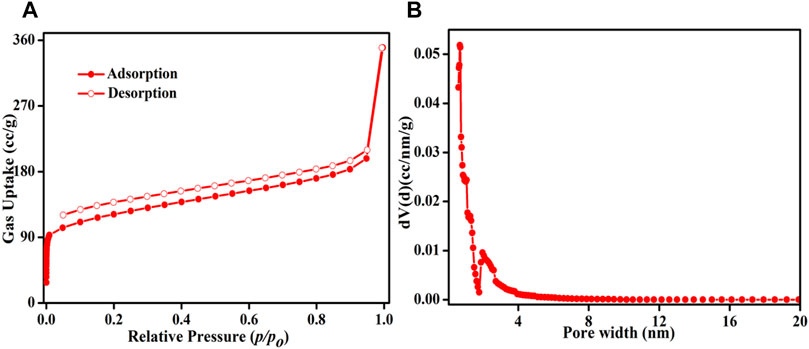
FIGURE 2. (A) N2 adsorption–desorption isotherms carried out at 77 K for HMP-TAPA. Closed circles represent adsorption and open circles for desorption. (B) Pore size distribution in HMP-TAPA.
The nitrogen (N) content of HMP-TAPA was estimated around 27.81% (C, H, and residue) by CHN analysis. This high N content, which also corresponds to the Lewis basic nature of framework, may be considered to increase its efficiency toward CO2 sorption and also its selectivity for CO2 molecules. It has been well-documented that N-rich frameworks with increased Lewis basic sites render high selectivity.
The selectivity for CO2 over N2 is an important requirement for CO2 adsorbence since the burning of fossils emits fuel gases that contain 15–16% CO2 having 0.15 bar partial pressure. Thus, to investigate the separation behavior of heptazine-based porous polymers, binary mixture selectivity at two different temperatures was estimated by the IAST method developed by Myers and Prausnitz (Myers and Prausnitz, 1965). It shows higher CO2 uptake than N2, which is about 106.7 mg/g and 11 mg/g at 273 K, (Figure 3B), respectively, (1 bar), and thus, it shows high selectivity of the heptazine-based framework toward CO2 molecules than N2. Furthermore, the Langmuir–Freundlich isotherm model was used for fitting the isolated sorption isotherms for CO2 and N2 (Supplementary Figures S3–S5). The observed selectivity for HMP-TAPA is 26.27 and 30.97 at 273 and 298 K, respectively, which is the highest achieved value among the heptazine-based porous polymers reported so far (Dang et al., 2015). Moreover, the strong affinity of heptazine-based porous frameworks toward CO2 has been explained on the basis of the dipole–quadrupole interaction between the N atoms in the pores and the adsorbed CO2 molecules (Oschatz and Antonietti, 2018). Thus, the selective CO2 sorption could be easily attributed to a high surface area and rich N content of the porous framework.
To gain further insights into CO2 adsorption efficiency, isosteric heat of adsorption (Qst) was calculated from the CO2 adsorption isotherm at 273, 281, and 298 K, according to the Clausius–Clapeyron equation (Figure 4). The Qst value measures the initial interaction strength at low gas loading and also establishes the physisorption/chemisorption interaction nature between the adsorbent gas (CO2) and the porous framework (HMP-TAPA). The Qst value was calculated to be 32.8 kJ/mol, which suggested a moderate interaction between CO2 molecules and free -N-, N–H, and -NH2 groups over the surface of the HMP-TAPA polymeric network.
Chemical and Thermal Stability of HMP-TAPA
Interestingly, the as-synthesized porous organic polymer (HMP-TAPA) was found to exhibit high chemical and thermal stability. To test the chemical stability, HMP-TAPA was soaked in different organic solvents (ranging from highly protic to aprotic) with vigorous stirring for 7 days and then the solids were recovered by filtration and washed thoroughly. Water stability was tested at various pH conditions in which HMP-TAPA was stirred in 6 and 9 M NaOH, 18 M H2SO4, and 12 M HCl solutions for 10 days (Figure 5A). HMP-TAPA was also found to be insoluble in boiling water, and this proved the remarkable stability of HMP-TAPA, as shown using FTIR (Figure 5A). This unusual behavior could be originating due to the heptazine core of the framework and the close stacking of aromatic rings, making the surface more hydrophobic.
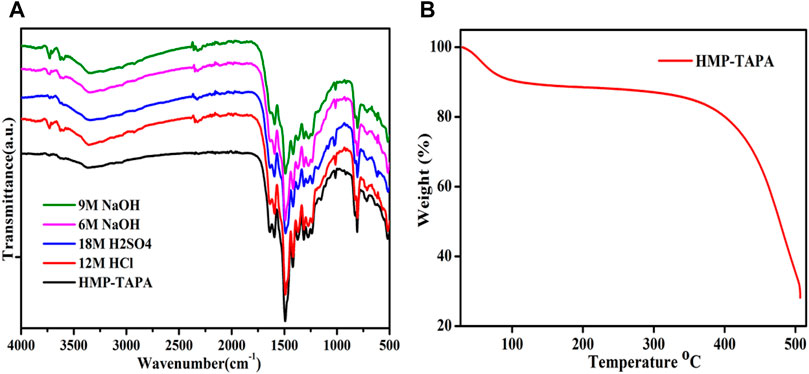
FIGURE 5. (A) Stability studies for HMP-TAPA analyzed using FTIR spectra over a period of 7 days in different solvents. (B) TGA plot for HMP-TAPA.
The thermal stability of the synthesized HMP-TAPA was determined by TGA. The TGA profile showed stability of HMP-TAPA up to 420°C, suggesting high thermal stability. The weight loss between 30°C and 100°C could be assigned to the removal of any organic solvent/moisture present in the framework (Figure 5B).
Catalytic Cycloaddition of Carbon Dioxide With Epoxides
A temperature-programmed desorption (TPD) measurement was performed to detect the concentration of basic sites under gaseous CO2 flow. TPD analysis showed two peaks at 92°C and 352°C, corresponding to the presence of weak and strong basic sites, respectively, as shown in Supplementary Figure S6. Mainly, the large number of N–H groups on the surface of HMP-TAPA accounted for the strong basic sites. However, the entire concentration of the basic sites was estimated to be 278 μmol/g. Motivated by the high thermal stability and chemical stability along with selective CO2 capture properties and high basic nature of HMP-TAPA, we envisioned that it can act as an efficient heterogeneous catalyst for the cycloaddition of CO2, as shown in Scheme 2. Therefore, the catalytic activity of HMP-TAPA was investigated for the cycloaddition reaction using styrene oxide as a model substrate (epoxide) at different conditions of CO2 pressure and tetra-butyl ammonium bromide (TBAB) as the co-catalyst.
To our surprise, the catalytic results showed the formation of the corresponding cyclic carbonate with about 98% conversion in 12 h (Table 1, entry nos. 1-9). Furthermore, controlled experiments revealed that both HMP-TAPA and TBAB are essential for the catalytic activity (Table 1, entry nos. 1–9). It is known that TBAB acts as a nucleophilic co-catalyst and facilitates the ring opening of the epoxides.

TABLE 1. Optimization of reaction conditions for cycloaddition of CO2 with styrene oxide catalyzed by HMP-TAPA.
With no additional by-products, 100% selectivity for cyclic carbonates was obtained (Figure 6). The progress of the catalytic reaction can be easily monitored by 1H NMR spectra of the aliquots taken at regular time intervals with reference to an internal standard (1,1′,2,2′-tetra-chloroethane). The time-dependent 1H NMR of styrene oxide is been shown in Figure 6.
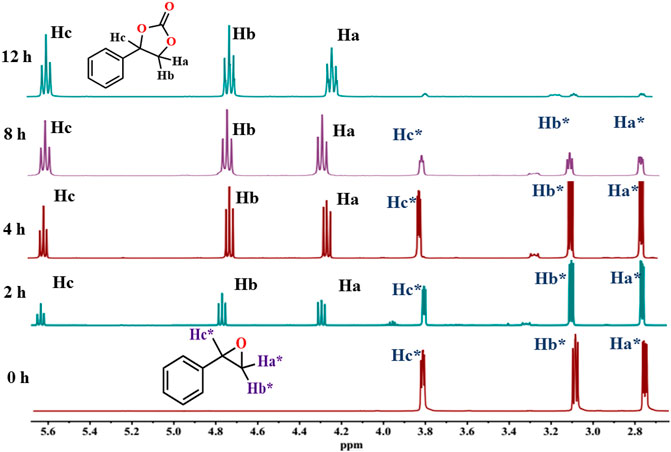
FIGURE 6. Time-dependent 1H CDCl3, 400 MHz NMR stack plot for the cycloaddition of CO2 with styrene oxide catalyzed by HMP-TAPA showing gradual increase of peaks at 4.3, 4.8, and 5.6 ppm corresponds to the product, and decrease in the intensity of peaks around 2.7, 3.1, and 3.8 ppm corresponds to styrene oxide.
The optimum conditions required for the cycloaddition reaction were investigated from the controlled experiments which revealed that a temperature of 80°C with catalyst:TBAB loading of (0.1 mol%) and CO2 pressure of 0.6 MPa are needed (Table 1, Entry no. 9). Having confirmed the optimum conditions for HMP-TAPA, the catalytic activity was further extended to other epoxides having different lengths of alkyl and aromatic units. Interestingly, the catalytic conversion of alkyl epoxides such as 1, 2-epoxybutane, 1, 2-epoxyhexane, and 1, 2-epoxydecane, were found to be lower than that of 1,2-epoxypropane, 2-methyl-1,2-epoxy propane, and epichlorohydrin, which can be attributed to their reduced activity owing to the presence of an alkyl chain which is shorter in case of the first three compounds (Table 2, entries 1 and 3 and Supplementary Figures S7–S8). Thus, the catalytic conversion can be correlated to the confinement in the pores of HMP-TAPA and restricted diffusion of the compounds with larger chain lengths having much slower activity (Table 2, entry 4 to 6 and Supplementary Figures S8–S10). The higher catalytic activity of HMP-TAPA can be attributed to the presence of high density of basic nitrogen sites, resulting in enhanced activity for selective CO2 capture and conversion. Also, butyl glycidyl ether gives relatively higher catalytic conversion over allyl glycidyl ether which can be ascribed to the electron-donating nature of the former than the latter (Table 2, entry 7-8 and Supplementary Figures S11–S12). Furthermore, aromatic epoxides, such as styrene oxide and phenyl glycidyl ether, were investigated for cycloaddition reaction, which showed a conversion of 81 and 57%, respectively. With the extended time for aromatic epoxides, it was found that styrene oxide takes 12 h and the latter takes 15 h for the complete conversion. (Table 2, entries 9–10 and Supplementary Figures S13–S14). It should be noted that the reaction conditions used in this study for the cycloaddition reaction are relatively milder than the conditions normally employed in the literature for triazine-based frameworks, as shown in Supplementary Table S1.
To rule out the possibility of homogeneous catalysis by HMP-TAPA precursors or monomers leached into the solution, the reaction was stopped at 4 h, and the conversion of styrene oxide was found to be ∼63%. Then the HMP-TAPA catalyst was removed by filtration, and the filtrate was allowed to stir for an additional 8 h in the presence of 6 bar pressure of CO2. (Figure 7A). The analysis of the aliquot taken at 12 h revealed a slight increase (∼2%) in the conversion of styrene oxide, which is considerably lower than the reaction carried out in the presence of HMP-TAPA. Furthermore, HMP-TAPA was easily separated from the reaction mixture by simple filtration and reused for subsequent cycles after washing with DCM/MeOH. Remarkably, the catalytic activity of HMP-TAPA was retained even after five consecutive cycles (Figure 7B). Also, the FT-IR spectra of the recovered sample were recorded, and it was found that the structure integrity and functional groups present were intact after catalysis (Supplementary Figure S15).
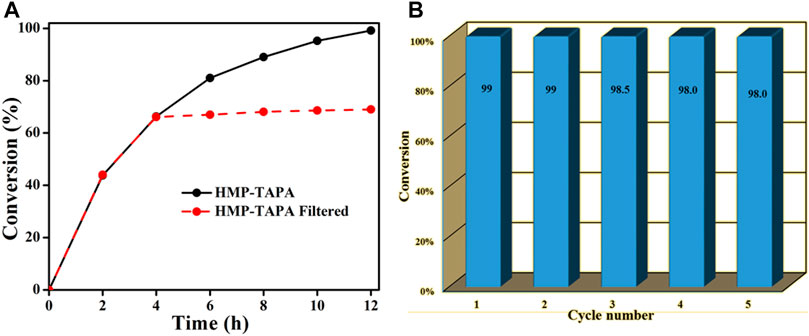
FIGURE 7. (A) Leaching test for the HMP-TAPA catalyst removed after 4 h. (B) Recycling test of HMP-TAPA for five successive cycles.
Plausible Mechanism
The proposed mechanism for the HMP-TAPA–catalyzed cycloaddition of CO2 with epoxides is shown in Scheme 3. The first step involves the polarization and subsequent coordination of CO2 at the basic -N-, -NH-, and -NH2- moieties present in TAPA and heptazine of HMP-TAPA, resulting in the formation of carbamate species which acts as a nucleophile. Furthermore, these carbamate nucleophiles attack epoxides present on the surface and assist in the ring opening of the epoxide. Also, TBAB helps in faster ring opening of epoxides, which further facilitates the selectivity of the cyclic carbonate in the reaction. The subsequent ring closure reaction by an intramolecular nucleophilic attack of the oxyanion with CO2 leads to the formation of cyclic carbonate. Then the reductive elimination of the cyclic carbonate regenerates the catalyst for incoming molecules of CO2 and epoxides, making the catalytic cycle as a continuous process.
Conclusion
The microporous polymeric network (HMP-TAPA) composed of a heptazine core shows the highest surface area among these classes of polymeric networks. The presence of a large number of -N-, -NH, and -NH2 groups on the surface of HMP-TAPA remarkably enhances the basicity of the polymer, which synergistically improved the CO2 sorption. HMP-TAPA exhibits permanent porosity with an IAST selectivity of 30.97 at 273 K ,which is highest among the heptazine-based porous polymers reported so far. In addition, the catalytic activity of HMP-TAPA was scrutinized for efficient and recyclable catalysts for the cycloaddition of CO2 with epoxides at relatively mild conditions, 0.6 MPa of CO2 and 80°C to generate cyclic carbonates in high yield and selectivity. The HMP-TAPA catalyst can be recycled for five successive cycles without significant loss of catalytic activity. The current study thus provides a hint that the heptazine-based porous organic polymers (HMPs) could be utilized for a wide variety of organic conversions (both thermal and photo-catalysis) and expecting more reports in the near future.
Supporting Information
PXRD plots of the compounds, FTIR, additional figures, gas adsorption–desorption isotherms, 1H NMR spectra, 13C NMR of heptazine chloride, CO2 TPD data, IAST selectivity, Langmuir–Freundlich, reaction in different solvents, and IR data to check chemical stability.
Data Availability Statement
The original contributions presented in the study are included in the article/Supplementary Material; further inquiries can be directed to the corresponding author.
Author Contributions
NS catalyst preparation and application, article writing, and data characterization and interpretation. BU data interpretation and article editing. SK catalyst preparation and characterization. KK research methodology and article correction.
Conflict of Interest
The authors declare that the research was conducted in the absence of any commercial or financial relationships that could be construed as a potential conflict of interest.
Publisher’s Note
All claims expressed in this article are solely those of the authors and do not necessarily represent those of their affiliated organizations, or those of the publisher, the editors and the reviewers. Any product that may be evaluated in this article, or claim that may be made by its manufacturer, is not guaranteed or endorsed by the publisher.
Acknowledgments
NS thanks INST Mohali for the financial support. KK acknowledges DST Nano Mission NATDP funded Technology Project, File No. SR/NM/NT-06/2016 for the financial support.
Supplementary Material
The Supplementary Material for this article can be found online at: https://www.frontiersin.org/articles/10.3389/fchem.2021.737511/full#supplementary-material
References
Aresta, M., Dibenedetto, A., and Angelini, A. (2014). Catalysis for the Valorization of Exhaust Carbon: from CO2 to Chemicals, Materials, and Fuels. Technological Use of CO2. Chem. Rev. 114, 1709–1742. doi:10.1021/cr4002758
Bala, I., Gupta, S. P., Kumar, S., Singh, H., De, J., Sharma, N., et al. (2018). Hydrogen-bond Mediated Columnar Liquid Crystalline Assemblies of C3-Symmetric Heptazine Derivatives at Ambient Temperature. Soft Matter 14, 6342–6352. doi:10.1039/c8sm00834e
Bala, I., Singh, H., Battula, V. R., Gupta, S. P., De, J., Kumar, S., et al. (2017). Heptazine: an Electron-Deficient Fluorescent Core for Discotic Liquid Crystals. Chem. Eur. J. 23, 14718–14722. doi:10.1002/chem.201703364
Battula, V. R., Singh, H., Kumar, S., Bala, I., Pal, S. K., and Kailasam, K. (2018). Natural Sunlight Driven Oxidative Homocoupling of Amines by a Truxene-Based Conjugated Microporous Polymer. ACS Catal. 8, 6751–6759. doi:10.1021/acscatal.8b00623
Bui, M., Adjiman, C. S., Bardow, A., Anthony, E. J., Boston, A., Brown, S., et al. (2018). Carbon Capture and Storage (CCS): the Way Forward. Energy Environ. Sci. 11, 1062–1176. doi:10.1039/c7ee02342a
Buyukcakir, O., Je, S. H., Talapaneni, S. N., Kim, D., and Coskun, A. (2017). Charged Covalent Triazine Frameworks for CO2 Capture and Conversion. ACS Appl. Mater. Inter. 9, 7209–7216. doi:10.1021/acsami.6b16769
Cao, S., Low, J., Yu, J., and Jaroniec, M. (2015). Polymeric Photocatalysts Based on Graphitic Carbon Nitride. Adv. Mater. 27, 2150–2176. doi:10.1002/adma.201500033
D'alessandro, D. M., Smit, B., and Long, J. R. (2010). Carbon Dioxide Capture: Prospects for New Materials. Angew. Chem. Int. Edition 49, 6058–6082. doi:10.1002/anie.201000431
Dang, Q.-Q., Zhan, Y.-F., Wang, X.-M., and Zhang, X.-M. (2015). Heptazine-Based Porous Framework for Selective CO2 Sorption and Organocatalytic Performances. ACS Appl. Mater. Inter. 7, 28452–28458. doi:10.1021/acsami.5b09441
Das, S., Heasman, P., Ben, T., and Qiu, S. (2017). Porous Organic Materials: Strategic Design and Structure-Function Correlation. Chem. Rev. 117, 1515–1563. doi:10.1021/acs.chemrev.6b00439
Ding, M., Flaig, R. W., Jiang, H.-L., and Yaghi, O. M. (2019). Carbon Capture and Conversion Using Metal-Organic Frameworks and MOF-Based Materials. Chem. Soc. Rev. 48, 2783–2828. doi:10.1039/c8cs00829a
Ema, T., Miyazaki, Y., Shimonishi, J., Maeda, C., and Hasegawa, J.-Y. (2014). Bifunctional Porphyrin Catalysts for the Synthesis of Cyclic Carbonates from Epoxides and CO2: Structural Optimization and Mechanistic Study. J. Am. Chem. Soc. 136, 15270–15279. doi:10.1021/ja507665a
House, K. Z., Harvey, C. F., Aziz, M. J., and Schrag, D. P. (2009). The Energy Penalty of post-combustion CO2 Capture & Storage and its Implications for Retrofitting the U.S. Installed Base. Energ. Environ. Sci. 2, 193–205. doi:10.1039/b811608c
Jacobson, M. Z. (2009). Review of Solutions to Global Warming, Air Pollution, and Energy Security. Energ. Environ. Sci. 2, 148–173. doi:10.1039/b809990c
Kailasam, K., Mesch, M. B., Möhlmann, L., Baar, M., Blechert, S., Schwarze, M., et al. (2016). Donor-Acceptor-Type Heptazine-Based Polymer Networks for Photocatalytic Hydrogen Evolution. Energy Technol. 4, 744–750. doi:10.1002/ente.201500478
Kailasam, K., Schmidt, J., Bildirir, H., Zhang, G., Blechert, S., Wang, X., et al. (2013). Room Temperature Synthesis of Heptazine-Based Microporous Polymer Networks as Photocatalysts for Hydrogen Evolution. Macromol. Rapid Commun. 34, 1008–1013. doi:10.1002/marc.201300227
Kitagawa, S., Kitaura, R., and Noro, S.-I. (2004). Functional Porous Coordination Polymers. Angew. Chem. Int. Ed. 43, 2334–2375. doi:10.1002/anie.200300610
Kroke, E., Schwarz, M., Horath-Bordon, E., Kroll, P., Noll, B., and Norman, A. D. (2002). Tri-s-triazine Derivatives. Part I. From Trichloro-Tri-S-Triazine to Graphitic C3N4 structuresPart II: Alkalicyamelurates M3[C6N7O3], M = Li, Na, K, Rb, Cs, Manuscript in Preparation. New J. Chem. 26, 508–512. doi:10.1039/b111062b
Kuruppathparambil, R. R., Babu, R., Jeong, H. M., Hwang, G.-Y., Jeong, G. S., Kim, M.-I., et al. (2016). A Solid Solution Zeolitic Imidazolate Framework as a Room Temperature Efficient Catalyst for the Chemical Fixation of CO2. Green. Chem. 18, 6349–6356. doi:10.1039/c6gc01614f
Lanzafame, P., Centi, G., and Perathoner, S. (2014). Catalysis for Biomass and CO2use through Solar Energy: Opening New Scenarios for a Sustainable and Low-Carbon Chemical Production. Chem. Soc. Rev. 43, 7562–7580. doi:10.1039/c3cs60396b
Li, J., Nakagawa, T., Macdonald, J., Zhang, Q., Nomura, H., Miyazaki, H., et al. (2013). Highly Efficient Organic Light-Emitting Diode Based on a Hidden Thermally Activated Delayed Fluorescence Channel in a Heptazine Derivative. Adv. Mater. 25, 3319–3323. doi:10.1002/adma.201300575
Li, P.-Z., and Zhao, Y. (2013). Nitrogen-Rich Porous Adsorbents for CO2 Capture and Storage. Chem. Asian J. 8, 1680–1691. doi:10.1002/asia.201300121
Ma, D., Li, B., Cui, Z., Liu, K., Chen, C., Li, G., et al. (2016a). Multifunctional Luminescent Porous Organic Polymer for Selectively Detecting Iron Ions and 1,4-Dioxane via Luminescent Turn-Off and Turn-On Sensing. ACS Appl. Mater. Inter. 8, 24097–24103. doi:10.1021/acsami.6b07470
Ma, R., He, L.-N., and Zhou, Y.-B. (2016b). An Efficient and Recyclable Tetraoxo-Coordinated Zinc Catalyst for the Cycloaddition of Epoxides with Carbon Dioxide at Atmospheric Pressure. Green. Chem. 18, 226–231. doi:10.1039/c5gc01826a
Makal, T. A., Li, J.-R., Lu, W., and Zhou, H.-C. (2012). Methane Storage in Advanced Porous Materials. Chem. Soc. Rev. 41, 7761–7779. doi:10.1039/c2cs35251f
Meng, X.-L., Nie, Y., Sun, J., Cheng, W.-G., Wang, J.-Q., He, H.-Y., et al. (2014). Functionalized Dicyandiamide-Formaldehyde Polymers as Efficient Heterogeneous Catalysts for Conversion of CO2 into Organic Carbonates. Green. Chem. 16, 2771–2778. doi:10.1039/c3gc42331j
Mukherjee, S., Das, M., Manna, A., Krishna, R., and Das, S. (2019). Newly Designed 1,2,3-triazole Functionalized Covalent Triazine Frameworks with Exceptionally High Uptake Capacity for Both CO2 and H2. J. Mater. Chem. A. 7, 1055–1068. doi:10.1039/c8ta08185a
Myers, A. L., and Prausnitz, J. M. (1965). Thermodynamics of Mixed-Gas Adsorption. Aiche J. 11, 121–127. doi:10.1002/aic.690110125
Oschatz, M., and Antonietti, M. (2018). A Search for Selectivity to Enable CO2 Capture with Porous Adsorbents. Energ. Environ. Sci. 11, 57–70. doi:10.1039/c7ee02110k
Pera-Titus, M. (2014). Porous Inorganic Membranes for CO2 Capture: Present and Prospects. Chem. Rev. 114, 1413–1492. doi:10.1021/cr400237k
Qu, J., Cao, C.-Y., Dou, Z.-F., Liu, H., Yu, Y., Li, P., et al. (2012). Synthesis of Cyclic Carbonates: Catalysis by an Iron-Based Composite and the Role of Hydrogen Bonding at the Solid/Liquid Interface. ChemSusChem 5, 652–655. doi:10.1002/cssc.201100839
Roeser, J., Kailasam, K., and Thomas, A. (2012). Covalent Triazine Frameworks as Heterogeneous Catalysts for the Synthesis of Cyclic and Linear Carbonates from Carbon Dioxide and Epoxides. ChemSusChem 5, 1793–1799. doi:10.1002/cssc.201200091
Rubin, E. S., Chen, C., and Rao, A. B. (2007). Cost and Performance of Fossil Fuel Power Plants with CO2 Capture and Storage. Energy Policy 35, 4444–4454. doi:10.1016/j.enpol.2007.03.009
Sakakura, T., Choi, J.-C., and Yasuda, H. (2007). Transformation of Carbon Dioxide. Chem. Rev. 107, 2365–2387. doi:10.1021/cr068357u
Sakakura, T., and Kohno, K. (2009). The Synthesis of Organic Carbonates from Carbon Dioxide. Chem. Commun., 1312–1330. doi:10.1039/b819997c
Sharma, N., Kumar, S., Battula, V. R., Kumari, A., Giri, A., Patra, A., et al. (2021). A Tailored Heptazine-Based Porous Polymeric Network as a Versatile Heterogeneous (Photo)catalyst. Chemistry 27, 10649–10656. doi:10.1002/chem.202100595
Sharma, N., Sharma, N., Srinivasan, P., Kumar, S., Balaguru Rayappan, J. B., and Kailasam, K. (2018). Heptazine Based Organic Framework as a Chemiresistive Sensor for Ammonia Detection at Room Temperature. J. Mater. Chem. A. 6, 18389–18395. doi:10.1039/c8ta06937a
Su, X., Bromberg, L., Martis, V., Simeon, F., Huq, A., and Hatton, T. A. (2017). Postsynthetic Functionalization of Mg-MOF-74 with Tetraethylenepentamine: Structural Characterization and Enhanced CO2 Adsorption. ACS Appl. Mater. Inter. 9, 11299–11306. doi:10.1021/acsami.7b02471
Tiba, S., and Omri, A. (2017). Literature Survey on the Relationships between Energy, Environment and Economic Growth. Renew. Sustain. Energ. Rev. 69, 1129–1146. doi:10.1016/j.rser.2016.09.113
Van Humbeck, J. F., Mcdonald, T. M., Jing, X., Wiers, B. M., Zhu, G., and Long, J. R. (2014). Ammonia Capture in Porous Organic Polymers Densely Functionalized with Brønsted Acid Groups. J. Am. Chem. Soc. 136, 2432–2440. doi:10.1021/ja4105478
Wang, K., Huang, H., Liu, D., Wang, C., Li, J., and Zhong, C. (2016). Covalent Triazine-Based Frameworks with Ultramicropores and High Nitrogen Contents for Highly Selective CO2 Capture. Environ. Sci. Technol. 50, 4869–4876. doi:10.1021/acs.est.6b00425
Wang, X., Maeda, K., Thomas, A., Takanabe, K., Xin, G., Carlsson, J. M., et al. (2009). A Metal-free Polymeric Photocatalyst for Hydrogen Production from Water under Visible Light. Nat. Mater 8, 76–80. doi:10.1038/nmat2317
Wang, X., Zhou, Y., Guo, Z., Chen, G., Li, J., Shi, Y., et al. (2015). Heterogeneous Conversion of CO2 into Cyclic Carbonates at Ambient Pressure Catalyzed by Ionothermal-Derived Meso-Macroporous Hierarchical Poly(ionic Liquid)s. Chem. Sci. 6, 6916–6924. doi:10.1039/c5sc02050f
Weber, J., Antonietti, M., and Thomas, A. (2008). Microporous Networks of High-Performance Polymers: Elastic Deformations and Gas Sorption Properties. Macromolecules 41, 2880–2885. doi:10.1021/ma702495r
Xu, Y., Wu, S., Ren, S., Ji, J., Yue, Y., and Shen, J. (2017). Nitrogen-doped Porous Carbon Materials Generated via Conjugated Microporous Polymer Precursors for CO2 Capture and Energy Storage. RSC Adv. 7, 32496–32501. doi:10.1039/c7ra05551j
Yaghi, O. M., O'keeffe, M., Ockwig, N. W., Chae, H. K., Eddaoudi, M., and Kim, J. (2003). Reticular Synthesis and the Design of New Materials. Nature 423, 705–714. doi:10.1038/nature01650
Yasuda, H., He, L., Sakakura, T., and Hu, C. (2005). Efficient Synthesis of Cyclic Carbonate from Carbon Dioxide Catalyzed by Polyoxometalate: the Remarkable Effects of Metal Substitution. J. Catal. 233, 119–122. doi:10.1016/j.jcat.2005.04.030
Yu, B., and He, L.-N. (2015). Upgrading Carbon Dioxide by Incorporation into Heterocycles. ChemSusChem 8, 52–62. doi:10.1002/cssc.201402837
Yue, C., Wang, W., and Li, F. (2020). Building N‐Heterocyclic Carbene into Triazine‐Linked Polymer for Multiple CO 2 Utilization. ChemSusChem 13, 5996–6004. doi:10.1002/cssc.202002154
Keywords: heptazines, porous organic polymers, heterogeneous catalyst, carbon dioxide sorption, cycloaddition of carbon dioxide
Citation: Sharma N, Ugale B, Kumar S and Kailasam K (2021) Metal-Free Heptazine-Based Porous Polymeric Network as Highly Efficient Catalyst for CO2 Capture and Conversion. Front. Chem. 9:737511. doi: 10.3389/fchem.2021.737511
Received: 07 July 2021; Accepted: 27 August 2021;
Published: 15 October 2021.
Edited by:
Sandipan Roy, Raghunathpur College, IndiaReviewed by:
Shin-ichiro Noro, Hokkaido University, JapanMarie-Pierre Santoni, Université de Paris, France
Copyright © 2021 Sharma, Ugale, Kumar and Kailasam. This is an open-access article distributed under the terms of the Creative Commons Attribution License (CC BY). The use, distribution or reproduction in other forums is permitted, provided the original author(s) and the copyright owner(s) are credited and that the original publication in this journal is cited, in accordance with accepted academic practice. No use, distribution or reproduction is permitted which does not comply with these terms.
*Correspondence: Kamalakannan Kailasam, kamal@inst.ac.in
 Neha Sharma
Neha Sharma